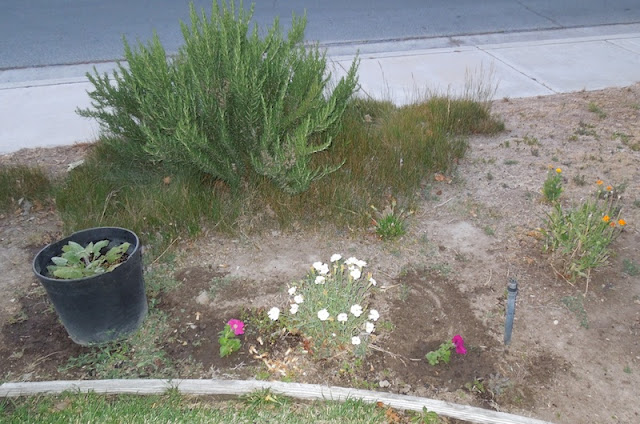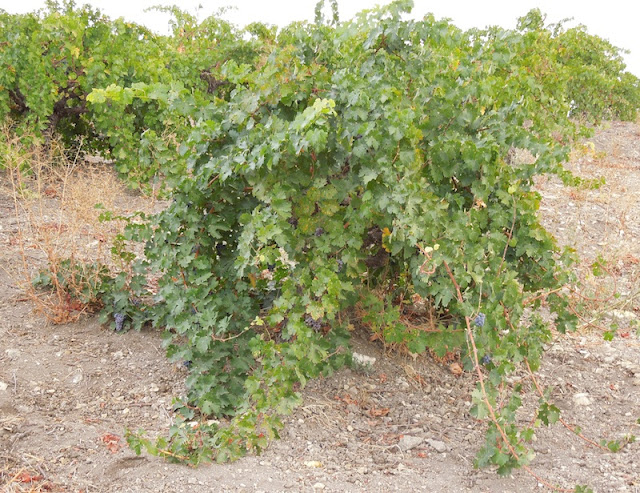A Seedling Can Sometimes Fool You
That's why I was I was caught off guard today when I found this new garden surprise. It's a mystery to me how this baby clary sage plant I found in bloom today got where it is. I will try to solve it here.
 |
| Surprise Clary Sage, © B. Radisavljevic |
Why This Baby Clary Sage Plant Surprised Me
In August, 2013, about a foot from where this small clary sage is blooming today, this borage plant was blooming. Borage reseeds easily.
 |
| Borage in Bloom and Companions, © B. Radisavljevic |
If the clary sage and borage are not next to each other and neither is blooming, they can be easily confused. This is especially true if there were no known clary sage plants in an area where you knew you had had borage. When I saw these seedlings in January, I just assumed they were borage and that they weren't yet mature enough to bloom.
 |
| Borage or Clary Sage Seedlings beside Calendula Flower © B. Radisavljevic |
The photo above shows you what I saw in that area in February 2015. What I believed to be the borage seedlings are to the right of the orange calendula flower. The eggshells are for snail control. The small plant closest to the flower, with the touch of blue, might actually be borage. It's hard to tell.
Seedlings Easily Confused with Borage
All of the plants pictured above have leaves of similar shape. They all grow as rosettes, with leaves coming from the center. Clary sage and mullein are so similar in looks that the person who sold me my first mullein had it labeled a clary sage, and later discovered her mistake. After the plant bloomed, it didn't look anything like a clary sage, so I went back to her and she was relieved to know who had gotten the mullein. She then gave me the genuine clary sage you see above.
Meanwhile, I had enjoyed the mullein so much I bought another when Fat Cat Farm was going out of business. That's the mullein you see above. The borage on the left is growing near some catmint (extreme left). There's no doubt about what it is since it's in full bloom now. In fact, in this heat it's beginning to fade and reseed. The photo below was taken during the first week of April.
 |
| Borage in Bloom near Calendula, Catmint, and Hyssop © B. Radisavljevic |
Above, the borage is in the middle with light blue flowers. The yellow calendula is nearest the lawn. In between is a pot of catmint that has escaped into the flower bed. It has the very faint blue flowers you see. The purple flowers at the back are hyssop just beginning to bloom. I love its deep color. It's in full bloom today and I'll be sharing that photo in a future post.
So How Did a Clary Sage Plant Emerge Where it Did?
I suppose seeds could have drifted over from the main flower bed. In that case, this could be the mother plant, about five yards from the baby clary sage.
 |
| Clary Sage in Bloom beside Tricolor Sage and Oregano © B. Radisavljevic |
The clary sage is the only blooming plant in the photo above. Its leaves are curling during the hot part of the day. I'm sure this is the mother of my baby sages. Even if the seeds were not carried to the new location from here, they may have been planted in 2013. I just remembered that when I was transferring the clary sage to a pot, I had the pot very close to where those new plants are.
 |
| Young Potted Clary Sage in February © B. Radisavljevic |
At the time I wasn't sure where I would put the potted clary sage. The pot is sitting only five feet from where my new baby plants are. By the time I moved the pot to its current location in the middle of June, it was in full bloom. It's quite possible some seeds were ready to fall and dropped as I was moving the plant. It is also possible that the seeds lay dormant until we got enough rain to germinate them. This would seem to fit the time frame for the plants being in bloom now.
To me it's a bit of a miracle that these should germinate and bloom. According to the Rodale's Illustrated Encyclopedia of Herbs, sage seeds store poorly, yet these just dropped into the ground and stayed until conditions were right for germination. Once they germinate, it takes them two years to actually mature enough to bloom. If they germinated in the rains of 2014, they are right on schedule. I believe the mystery of the baby clary sage has been solved.
What do you think? If you enjoyed solving this mystery with me, please share it with your friends. You will find sharing buttons just below, above the comment box where you can tell me what you think. How do you think the the baby clary sage plants got here?









































